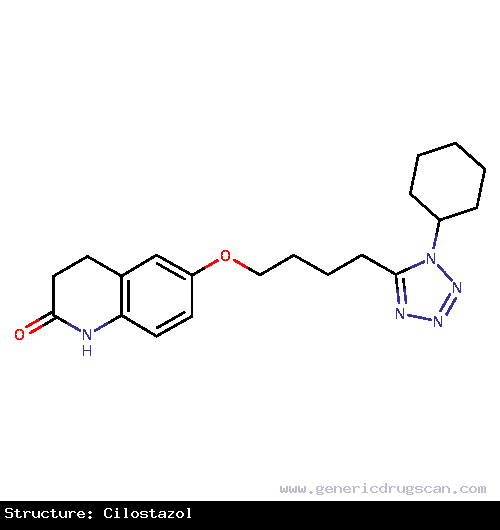Cilostazol Drug: Indication, Dosage, Precaution, Side Effect , Storage, Category Type and corresponding Brands - www.genericdrugscan.com
Cilostazol
Drug Status in USA : Approvedpronunciation
pronounced as (sil oh' sta zol)
Why is this medication prescribed?
Cilostazol is used to reduce the symptoms of intermittent claudication (pain in the legs that worsens when walking and improves when resting that is caused by narrowing of the blood vessels that supply blood to the legs). Cilostazol is in a class of medications called platelet-aggregation inhibitors (antiplatelet medications). It works by improving blood flow to the legs.
How should this medicine be used?
Cilostazol comes as a tablet to take by mouth. It is usually taken twice a day, at least 30 minutes before or 2 hours after breakfast and dinner. Take cilostazol at around the same times every day. Follow the directions on the prescription label carefully, and ask your doctor or pharmacist to explain any part you do not understand. Take cilostazol exactly as directed. Do not take more or less of it or take it more often than prescribed by your doctor.
Cilostazol controls the symptoms of intermittent claudication but does not cure it. Although you may notice improvements in 2 to 4 weeks, it may take up to 12 weeks before you notice the full benefit (increased walking distance) of cilostazol. Continue taking cilostazol even if you feel well. Do not stop taking cilostazol without talking to your doctor.
What are the precautions to be followed?
Before taking cilostazol,- tell your doctor and pharmacist if you are allergic to cilostazol, any other medications, or any of the ingredients in cilostazol. Ask your pharmacist for a list of the ingredients.
- tell your doctor and pharmacist what other prescription and nonprescription medications, vitamins, nutritional supplements, and herbal products you are taking or plan to take. Be sure to mention any of the following: anticoagulants (''blood thinners'') such as warfarin (Coumadin); aspirin; antifungal medications such as fluconazole (Diflucan), itraconazole (Sporanox), and ketoconazole (Nizoral); antiplatelet medications such as clopidogrel (Plavix), prasugrel (Effient), and ticlopidine (Ticlid); clarithromycin (Biaxin); diltiazem (Cardizem, Dilacor, Tiazac, others); erythromycin (E-mycin, Ery-Tab, others); fluoxetine (Prozac); fluvoxamine (Luvox); nefazadone; omeprazole (Prilosec); and sertraline (Zoloft). Your doctor may need to change the doses of your medications or monitor you carefully for side effects.
- tell your doctor if you have bleeding ulcers (sores in the lining of the stomach or small intestine that are bleeding), bleeding in the brain, bleeding from any other part of your body, a low number of platelets in your blood, or any other condition that causes severe bleeding. Your doctor will probably tell you not to take cilostazol.
- tell your doctor if you have or have ever had heart, kidney, or liver disease.
- tell your doctor if you are pregnant, plan to become pregnant, or are breast-feeding. If you become pregnant while taking cilostazol, call your doctor.
What are possible side effects of this medication ?
Cilostazol may cause side effects. Tell your doctor if any of these symptoms are severe or do not go away:- headache
- diarrhea
- dizziness
- heartburn
- nausea
- stomach pain
- muscle pain
- fast or irregular heartbeat
- unusual bleeding or bruising
- swelling of the arms, hands, feet, ankles, or lower legs
How to store the medication and dispose it of after its use later?
Keep this medication in the container it came in, tightly closed, and out of reach of children. Store it at room temperature and away from excess heat and moisture (not in the bathroom).
Unneeded medications should be disposed of in special ways to ensure that pets, children, and other people cannot consume them. However, you should not flush this medication down the toilet. Instead, the best way to dispose of your medication is through a medicine take-back program.
Drug Category/Class
- Fibrinolytic Agents
- Platelet Aggregation Inhibitors
- Bronchodilator Agents
- Phosphodiesterase 3 Inhibitors
- Vasodilator Agents
- Neuroprotective Agents
- Antithrombotic Agents
- Blood and Blood Forming Organs
- Platelet Aggregation Inhibitors Excl. Heparin
- Cytochrome P-450 CYP1A2 Inhibitors
- Cytochrome P-450 CYP1A2 Inducers
- Cytochrome P-450 CYP2C19 Inducers
- CYP2D6 Inducers
- CYP2D6 Ind
| Prescribed | For the reduction of symptoms of intermittent claudication (pain in the legs that occurs with walking and disappears with rest). |
| Weight : | 369.4607 |
| Structure | Cilostazol |
 | |
| Formula | C20H27N5O2 |
Cilostazol has 18 Brands listed
Search Generic Drugs alphabetically
